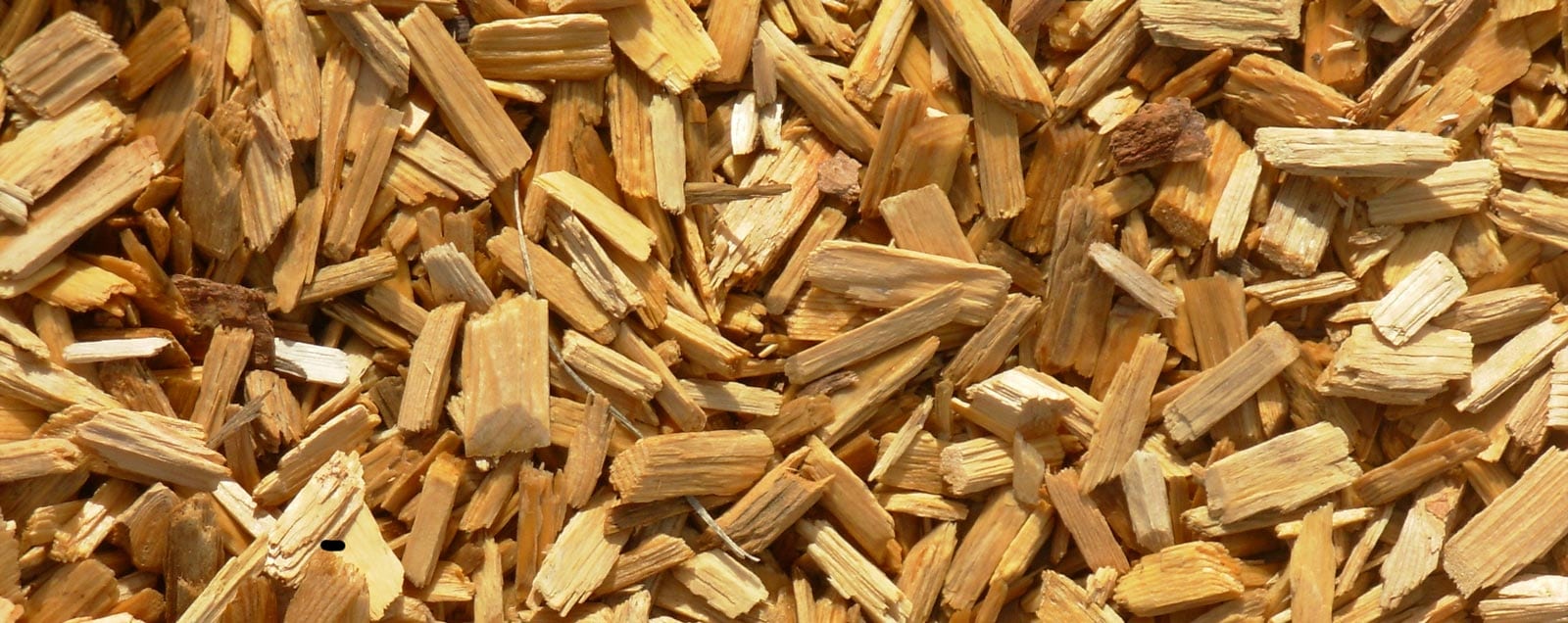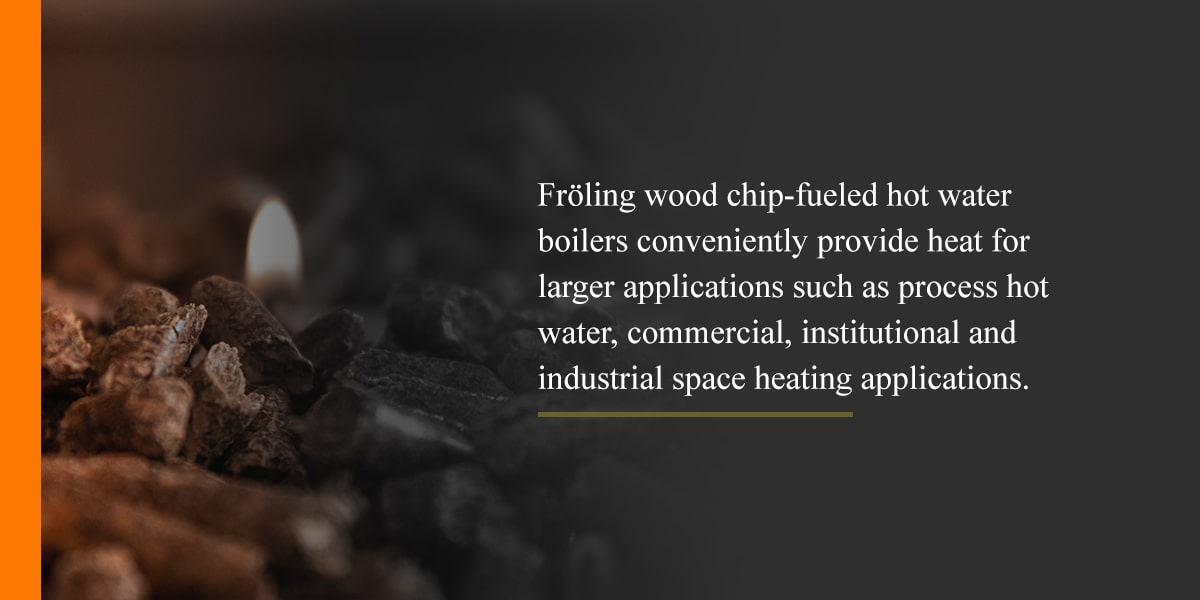Guide to Wood Chip Boilers

Wood chip heating is becoming an increasingly popular commercial heat source nationwide. Wood chip boilers, commonly referred to as wood chip stoves or wood chip furnaces, are an environmentally friendly alternative to fossil fuels like propane and oil. For engineers looking to heat commercial facilities with optimal efficiency, wood chip heating is an excellent option with many unique advantages.
Overview of Wood Chip Heating Systems
Some wood chip boilers burn whole tree chips. These are generally very large, industrial-scale boilers with outputs larger than 2 Million Btus/hr. Froling wood chip heaters burn wood chipped from the trunk of the tree. The wood chips are of specific size and moisture content for different boiler types/sizes. The chips are burned at high temperatures on grates in fireboxes surrounded by thick firebrick lining. The resulting exhaust stream exchanges heat with water, which is then distributed to heat loads. Each wood chip boiler is slightly different depending on the size and brand, but the overall mechanism operates as follows:
- Wood chips remain in a covered storage area close to the heater. Green wood chips must be kept from freezing. Dry wood chips can be stored in freezing conditions. Augers, belt conveyors or walking floors automatically move chips to the boiler to match heating needs.
- As the wood chips enter the combustion chamber, hot air ignites them to start the burning process.
- Moving grates move fuel through the combustion process and remove ashes automatically to clean the combustion zone, preventing buildup.
- The heat is circulated and removed from the combustion chamber to heat water. Heat is then transferred to process heat loads, building space or potable water.
You can connect multiple wood chip heaters for larger heating loads to secure a reliable, sustainable heat source that is able to meet a wide range of heat loads. Wood chips are renewable resources that enable heating engineers to specify dependable and renewable heat sources for various types of facilities.
The Benefits of Burning Wood Chips

As oil prices have increased, many companies are looking for alternative ways to heat commercial buildings and institutions. To encourage business owners and engineers to make sustainable renewable energy retrofits, several states incentivize commercial and institutional installations of wood chip boilers.
Understanding the benefits of wood chip heaters can help you determine how implementing one can enhance your heating experience.
1. Lower Costs
Wood chips are made from low-value wood that is culled when the wood is harvested for lumber. Chips have relatively stable prices compared to oil, propane, natural gas and other fossil fuels. More consistent prices allow you to better budget for each season’s heating costs.
While wood chip fuel is more cost-stable, it is also substantially less expensive than fossil fuels. Wood chips are supplied by local forestry companies with community connections. Wood chips, therefore, save money for operators while keeping fuel expenditures circulating in local communities.
2. Positive Global Impact
Burning wood chips in modern boilers creates very low harmful emissions. Advanced controls, extremely hot combustion chambers, and precise air delivery ensure complete fuel burn out. Harmful tars are eliminated from the exhaust stream. Burning waste wood from sustainably managed forests is nearly carbon neutral. What’s just as important is that by utilizing waste wood, landowners and forest managers are better able to retain their forests as forests. Trees are essential and natural carbon dioxide absorbers. Using wood responsibly can therefore augment a circular carbon cycle.
3. Energy Efficiency
Quality wood chip burners use advanced controls to produce the most energy possible. Advanced wood boiler companies like Froling give thoughtful consideration to combustion design and control. As well, all electric components, such as fan motors and actuators are chosen to reduce power consumption. Sizing a wood chip boiler correctly to match the heating load allows boilers to operate at a steady state, which is the most efficient form of operation.
Wood Chip Boilers From Fröling
Fröling wood chip-fueled hot water boilers conveniently provide heat for larger applications such as process hot water, commercial, institutional and industrial space heating applications.
Fröling chip boilers are ASME-stamped boilers designed for indoor use. Fuel feeding, ignition, grate cleaning, heat exchange cleaning and de-ashing are all automatically controlled. Combustion is actively controlled using variable induction fan speed, variable grate control and motorized air controls. Fröling wood chip boilers respond to heating loads by ramping output up and down while minimizing on/off cycles. The use of properly sized thermal buffer and balancing flow in the system ensures smooth and successful boiler operation throughout a range of thermal demands.
Fuel storage is located adjacent to the boiler to minimize space and conveyance costs. Chips are usually stored in a flat bottomed bin. The fuel is generally moved to an auger with a rotary feeder or with a scraper floor. From the feed auger, fuel passes through a safety airlock into the stoker channel. The stoker is often an auger, but the Fröling Turbomat can utilize a hydraulic ram, which is used for larger chips or more inconsistent fuel.
The Fröling Turbomat can use wood chips with up to 45% moisture content. The Fröling T4 can use wood chips with up to 30% moisture content. The Turbomat has a much longer grate surface than the T4. The grate surface in the Turbomat moves chips horizontally. Chips enter unburned and exit 7 feet away as ashes. The theory is that wood chip fuel can either be dried outside of the boiler or within the boiler.
Boilers with heavier, brick-lined fireboxes and longer grates can typically handle wetter chips. These two structural attributes help the wet chips to dry as they combust within the boiler. The brick lining allows for an extremely hot environment (up to 900 C).
Smaller and lighter boilers must have dry chips to ensure complete combustion because it is not possible to adequately dry the chips in relatively small combustion chambers surrounded by water. The result can be incomplete combustion to have a smaller infrastructure at the boiler site and to use dry chips.
Sometimes, larger chip boilers and less expensive, wetter fuel make better economic sense. Projected chip consumption, physical space and initial capital costs will usually determine what type of wood chip boiler right for your application.
Historically, heating with wood chips costs about 1/2 the cost of conventional fuels such as fuel oil and propane. The greater the volume of conventional fuel that is offset, the greater the savings.
How Much Fuel Do I Need for a Wood Chip Burner?
The amount of fuel you'll need for your wood chip boiler depends on the specific model you choose and the heating load.
